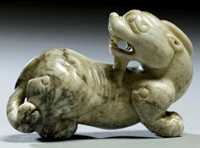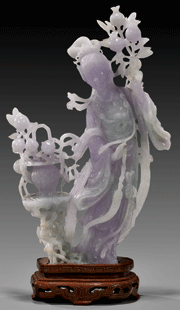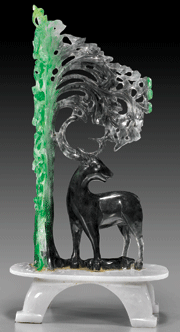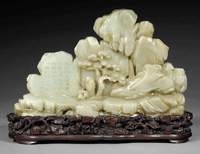|
Green With Envy: Collecting Jade
By I.M. Chait
Posted September 2012
Jade is a fascinating subject, as well as a fascinating material. There is not just one stone called jade. For example, the word jade is commonly used when referring to nephrite, which can be in shades of white, greenish white, mutton-fat white, sea green, leaf green, spinach green, black and a host of other colors. The skin, or rind, of the jade pebble or boulder is often of brown or tan coloration and can also be used in the execution of the object.
Then there is another material called jade, actually a totally different mineral, which is of a more crystalline nature, and it is called jadeite. When jadeite is totally opaque and extremely dark, it is often referred to as chloromelanite. Interestingly, jadeite comes in even more colors than nephrite and can be nearly transparent (sometimes referred to as water jade) or highly translucent. It is the jade, when it is a lovely green, lavender or red color, and it is most often used as jewelry.
Why would someone want to collect jade? There are as many answers to that question as there are types of jade. First of all; the word jade is magical, mysterious and mythical. In just four letters, it exemplifies 5,000 years of Chinese history, and it counterpoints everything thought of when thinking about China. If you were to ask the average person the first thought that comes to mind when China is mentioned, and they might say “Chinese food” or “the Great Wall” or “fortune cookies,” but within a few minutes, you would hear the word jade.
Here you are, and you want to buy a piece of jade, or you want to collect jade. The first thing you need to learn is to differentiate, or to be certain, when a stone is actually jade.
This sounds pretty simple; yet, it’s so vastly complicated so as to have fooled thousands and thousands of people over and over again. The old test for jade was hardness. If you wanted to test the stone, you took a sharp steel knife and tried to scratch it. If it didn’t scratch, you assumed it was jade. In reality, this test is still somewhat valid.
Nowadays, we have complex gemological testing, such as specific gravity and refractive index, to help us differentiate, but sometimes, collecting other hard stones is just as much fun as collecting jade, if you are doing it with certainty.
In ancient China, they only had one word for jade, and that word was Yu. Not having gemological testing devices to measure refractive index or specific gravity, their only test for jade was hardness. This meant that some agates and quartzes were also included in the jade category.
Let’s look at antique jade by first looking at its early ancestors. In Neolithic primitive China, jade was used for tools and weapons because of its hardness. This was nephrite in various colors, usually dark. Nephrite was also used as a material to carve and create burial objects, which were placed in tombs as ornamentation for the dead to assist them in their afterlife. It’s an interesting anecdote that other early civilizations, such as the Mayans, also revered jade, but their burial objects are generally made of jadeite rather than nephrite.
As stories go about jade, sometime in the early 18th century, a boulder of a beautiful, hard mineral, translucent and with lovely brilliant green markings, was presented to the Chinese emperor (probably Qianlong) as a tribute from Burma. The emperor was so fascinated with the material that he had objects and jewelry created from it, and that started the use of green jades in ornamentation. Please note that when I say “green,” there could be light-green suffusions, there could be all-over apple green, and there could be brilliant and translucent emerald green, which is commonly referred to as Imperial jade.
Here we are now in the 21st century, and of course, people want to collect jade. The best quality nephrite has been of spinach color from Siberia or white and greenish-white pebbles from Turkestan, but other jades have been used or ornamentation. For example, British Columbian jade can look very much like Siberian jade. California jade is dark green and muddy, but it has been used to make old-looking pieces. White jade was also found in Korea in the 1970s, and within the last decade, there have been other minerals found like white jade but that are not.
This brings us to a subject of great interest and contention—the quantity of available fine antique jade is extremely low. Much was carved during the last 1,000 years, but little comes on the market, except as large collections which have sold internationally and for monumental prices. What this did was create a market for jade carvings “looking like” Song or Ming or 18th century and being sold as such. My formula for value is a triangle that says it is a function of material, workmanship and age. The point I am making here is that if one has really fine material, really fine workmanship, and little or no age, the value still remains exceedingly high.
Let me just give you some examples. I have traveled to China probably 100 times or more over the past 30 years, and when going to the factories or so-called “Antique Arcades” or “Curio Cities,” one can see the cost of materials themselves changing on each trip. I would say that now, currently in 2012, the price of any relatively well carved white or greenish white jade is starting to approach prices of antique jades, primarily due to the value of the material and the cost of workmanship. Given that the tools and polishing materials that are currently available are so far superior to what was available in the past few hundred years, one marvels how indeed beautiful antique jades could have been created, and one is not surprised that these pieces now bring astronomical prices at auction.
Let me explain how a Chinese jade carver working in an imperial factory sometime in the last few hundred years would consider his creation. This story has been repeated countless times by various poets and scholars, and I am certain that it is actually true. When jade pebbles or sizeable rocks were brought to a carver, he would study carefully the nature of the natural-formed mineral. He could then “see” in his mind’s eye what could and should come out of that piece of jade. It is normally referred to as the carving or sculpture already being there; all he had to do was remove the excess. This is what forms the intrinsic beauty of what we consider the finest nephrite carvings, and these would come from the Middle Qing Dynasty, 17th and 18th centuries.
Interestingly enough with jadeite, some of the most valuable carvings come from the very late Qing Dynasty or Republic Period because the stones were being picked primarily for the value of the mineral based upon color and translucence.
Unfortunately, today we are confronted with the ability to change the color of jadeite by impregnation of polymer resin, giving the appearance of fine color. Over the centuries, there have been numerous ways in which jade, especially jadeite, has been made to change color. One of the oldest methods was to heat the stone (jadeite) to a very high temperature and then drop it into a container of liquid dye at room temperature or colder. Since jadeite is crystalline in nature, the sudden cooling of the stone would cause fracturing in the internal structure. This fracturing will pull dye into the fractures and obviously into the stone itself. On occasion, the stone might shatter, but often, this method would work.
The resin impregnation methodology has been around for 30-plus years, but in the last decade, it has become so natural in appearance as to require gemological testing. Nowadays, when a stone is tested and found to be free of resin, it is given the classification of grade A jadeite. When resin is detected, the grading is B.
We are also faced with the ability to change the nature of Nephrite by various acids and chemicals and the process of burning to give the appearance of being many hundreds or even a few thousand years old. So how does one differentiate? That, my friends, will be the subject of future articles.
-------------------------
Isadore M. Chait is a licensed auctioneer in the State of California and for decades has been holding the only monthly auctions in Southern California devoted to Asian Fine Arts. According to Architectural Digest, "Isadore Chait, specialist in Oriental sculpture and expert in gemology, has developed a world-wide reputation among museums and collectors and is frequently consulted by both groups for authentication, market value and appraisals." He is a recommended appraiser for many museums and universities, including the J. Paul Getty Museum, the Norton Simon Museum, the Los Angeles County Museum of Art, the University of California at Los Angeles, and the Claremont University Center. In the past three decades, he has been to China over 100 times. During the last four decades, he has been professionally evaluating, authenticating, buying and selling Asian antiques and antiquities.
|

Ming Dynasty carved grayish-tan “chicken-bone” jade model of a qilin (a mythical creature comprised of parts of different animals); 2 ¾ inches.

Carved lavender jadeite figure of a beauty; 9 inches in diameter.

Very finely carved, translucent, black-and-green jadeite group of deer; 5 5/8 inches in height.

18th century Qianlong Period carved celadon jade “mountain”; 6 ½ inches long.
|